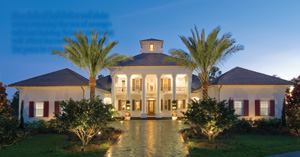When the decree “Let there be light,” came from above, it didn’t specify exactly what type of light that should be. Today, the state of California, AHSRAE, and the U.S. Congress, among others, have taken up that charge. Cutting-edge energy laws and building codes—along with the swelling green movement—are changing the nature of lighting and how it will be controlled in the future home.
California’s Title 24, part of the California State Building Code, is being viewed by many as the green model for next-generation residential lighting. The code specifies on a room-by-room basis the percentage of lighting that must be energy efficient. Kitchens and utility areas are required to use 50 percent high-efficacy lighting, such as compact fluorescents. If a combination of lighting types—CFL and incandescents—is used in those rooms, they have to be switched independently. Lighting in traditional living spaces—family rooms, dining rooms and bedrooms—can incorporate dimming as one of the means to energy reduction.
More than a few eyes are on Title 24 to monitor its effectiveness both in implementation and energy reduction. “California leads the country in a lot of things,” says Gary Meshberg, business development manager at Genlyte Controls (a unit of Philips) and chairman of the Home Lighting Control Alliance (HLCA). “And they have had a great deal of influence on ASHRAE, which has taken steps from Title 24,” he says. “It’s difficult for states to push their own set of standards,” he says, “so they’ll adopt what’s done nationally.”
At the federal level, the Energy Independence and Security Act of 2007 focuses largely on lamp types rather than lighting control. According to David Bruce, vice chairman of the HLCA and national sales manager for Square D, incandescent bulbs rated at 40 to 100 watts will be eliminated from the market in 2012. “The new law is promoting compact fluorescent lamps instead,” Bruce says, “but unfortunately there’s not a lot of promotion of dimming as an answer to energy concerns.”
That’s one of the things HLCA hopes to accomplish as an alliance. “We want to elevate what we do as solutions,” Bruce says. “The Energy Act is very focused on the elimination of standard incandescent bulbs and promotes the use of compact fluorescents, but it doesn’t talk much about alternate lighting sources or lighting control.”
Changes in lamp specifications will affect everyone from lighting manufacturers to consumers who go into stores to buy their tried-and-true incandescents only to find they’ve been replaced either by low-watt CFLs or new bulb types altogether.
Lighting companies want their customers to know that their switches and dimmers will continue to work within the scope of the new legislation, even if consumers can no longer find a 75-watt incandescent bulb. “A common belief is that the incandescent bulb is being banned when this is not the case,” says Rich Black, engineering project manager for Lutron Electronics. “Rather, minimum efficiency standards have been legislated, meaning that the current low-tech version of the incandescent light bulb will become obsolete.”
Compact fluorescents (CFLs) are the bulb of choice among energy misers today. Energy Star-rated bulbs use 75 percent less energy than incandescent bulbs and last up to 10 times longer. According to CFL manufacturer GE, replacing a 60-watt incandescent with a 13-watt CFL can save $30 in energy costs over the life of the bulb.
On the down side, CFLs give off a cool light that many perceive as sterile, although newer bulbs have reportedly made strides toward a warmer appearance. Their biggest drawback is that they typically can’t be dimmed in the way consumers expect to achieve a warm feel. Starting from a cold off, there’s a warm-up time, then a color change, and then the light stabilizes after about two to three minutes, says Meshberg of the HLCA. “The candlelight effect you enjoy with incandescent dimmers is gone,” he says. “When fluorescents dim, they dim whiter rather than amber like candlelight.”



